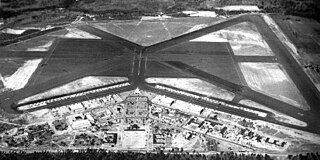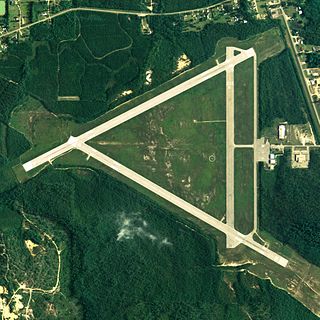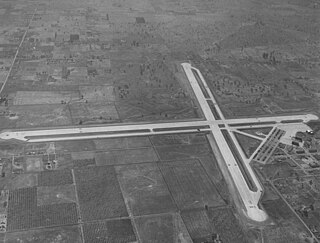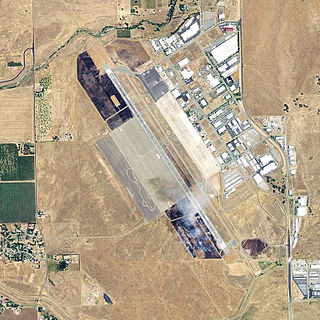
Naval Air Station Alameda was a United States Navy Naval Air Station in Alameda, California, on San Francisco Bay.

A naval air station is a military air base, and consists of a permanent land-based operations locations for the military aviation division of the relevant branch of a navy. These bases are typically populated by squadrons, groups or wings, their various support commands, and other tenant commands.

Saufley Field is a military airport and support facility located in unincorporated Escambia County, Florida, United States, five nautical miles (9 km) west of the central business district of Pensacola.
Flagler Executive Airport (ICAO: KFIN, FAA LID: FIN) is a county-owned public-use airport located three miles (5 km) east of the central business district of Bunnell, a city in Flagler County, Florida, United States. The airport's former FAA location identifiers were X47 and XFL. The airfield was originally constructed by the United States Navy during World War II as Naval Outlying Field Bunnell (NOLF Bunnell), an auxiliary airfield for flight training operations originating from nearby Naval Air Station Jacksonville, NAS Daytona Beach and NAS DeLand. Following the end of the war, the airfield was transferred from the Navy to Flagler County for use as a general aviation airport.

Brewton Municipal Airport is a city-owned public-use airport located 3 nautical miles (6 km) south of the central business district of Brewton, a city in Escambia County, Alabama, United States. Originally constructed by the U.S. Navy during World War II as an auxiliary field to the Naval Air Station Pensacola complex, it was later redesignated as Navy Outlying Landing Field (NOLF) Brewton before being conveyed to the city of Brewton as a public use facility. Although under civilian ownership, the airfield still functions concurrently as NOLF Brewton and is used by Navy training aircraft located at Naval Air Station Whiting Field, Florida.

An outlying landing field (OLF) is an auxiliary airfield, associated with a seaborne component of the United States military. When associated with the United States Navy, they are known as naval outlying landing fields (NOLFs) or naval auxiliary landing fields (NALFs); when associated with United States Marine Corps, they are known as Marine Corps outlying fields (MCOFs) or Marine Corps auxiliary landing fields (MCALFs).

Naval Auxiliary Landing Field (NALF) Santa Rosa, California, also known as Naval Auxiliary Air Station, Santa Rosa, was a military airport located in Santa Rosa, California, in Sonoma County, California, USA.
Naval Outlying Landing Field Barin is a United States Navy airfield located in Foley, a city in Baldwin County, Alabama, United States.
Naval Outlying Field Goliad is a military airport located five nautical miles north of the central business district of Berclair, Texas, in Goliad County. It is owned by the United States Navy. The airfield has two runways, both 8000 feet long by 150 feet wide. Its mission is to support operations of the Naval Air Training Command, specifically Commander, Training Air Wing FOUR located aboard Naval Air Station Corpus Christi. It is under the control of Commander, Navy Region Southeast.

California during World War II was a major contributor to the World War II effort. California's long Pacific Ocean coastline provided the support needed for the Pacific War. California also supported the war in Europe. After the Japanese attack on Pearl Harbor on December 7, 1941, most of California's manufacturing was shifted to the war effort. California became a major ship builder and aircraft manufacturer. Existing military installations were enlarged and many new ones were built. California trained many of the troops before their oversea deployment. Over 800,000 Californians served in the United States Armed Forces. California agriculture, ranches and farms were used to feed the troops around the world. California's long coastline also put the state in fear, as an attack on California seemed likely. California was used for the temporary and permanent internment camps for Japanese Americans. The population grew significantly, largely due to servicemen who were stationed at the new military bases/training facilities and the mass influx of workers from around the U.S. in the growing defense industries. With all the new economy activity, California was lifted out of the Great Depression. Over 500,000 people moved to California from other states to work in the growing economy. California expanded its oil and mineral production to keep up with the war demand.

Helm Field also called Lemoore Auxiliary Army Airfield A-7 is a former US Army Airfield use for training during World War II. Helm Field was location in the town of Coalinga, California, 70 miles south of Fresno. Helm Field had two 3,000 foot runways, one oriented east/west and one oriented northwest/southeast. The Airfield was on a 773 acres site of form farm land. The US Army purchased the land on January 11, 1943 for training pilots. The Airfield was used by the Lemoore Basic Flying School, based at the Lemoore Army Air Field. Helm Field was 15 miles northwest of Lemoore Army Air Field. The Army built at Helm Field to support training stage house, control tower, motor pool building, crash truck shelter and latrines. Helm Field was used by Air Corps Basic Flying School, the AAF Basic Flying School, the AAF Pilot School, the 88th Air Base Squadron, the 3023rd Army Air Force Pilot School and the 461st Army Air Force Base Unit. The army closed Helm Field on October 15, 1844 and the Airfield was sold by the War Assets Administration. Helm Field was used as a farm labor camp in the 1950s. The east/west runway was returned to farmland. The northwest/southeast runway was still intact and was used as a civilian airfield till 1971.

Chico Army Airfield auxiliary fields were a number of airfields used during World War II to support the Chico Army Airfield. On September 11, 1941, the US Army rented from the City of Chico a small 1930's airport that sat on 160 acres (0.65 km2) of land. The Airfield was five miles (8.0 km) north of the city center. The Army built up the small airport into the Chico Army Airfield. From the Chico Army Airfield operated the: United States Army Air Corps's Army Air Forces Basic Flying School, the Army Air Force Pilot School, the 10th Base Headquarters an Air Base Squadron and the 433rd Army Air Force Base Unit or Combat Crew Training Station of Fighter. To support the training of the many pilots, Chico Army Airfield operated a number of auxiliary airfields. Some auxiliary fields were no more than a landing strip runway, others were other operation airfield that supported the training at the Chico Army Airfield.

Naval Air Station Livermore has nearby airfield landing strips to support the training of US Navy pilots during World War 2. The airfield are called Naval Outlying Landing Field (NOLFs). For the war many new trained pilots were needed. The Naval Outlying Landing Fields provided a place for pilots to practice landing and take off without other air traffic. The remotes sites offered flight training without distractions. Most of the new pilots departed to the Pacific War after training. The Outlying Landing Fields had little or no support facilities. Naval Air Station Livermore opened in 1942 and closed in 1951. The Outlying field closed in 1945, having completed the role of training over 4000 new pilots. To open the needed Outlying Landing Fields quickly, the Navy took over local crop dusting and barnstorming airfields.

Naval Air Station Los Alamitos Naval Outlying Landing Fields were a set airfield near Naval Air Station Los Alamitos to support the training of US Navy pilots during World War 2. The support airfields are called Naval Outlying Landing Field (NOLF). For the war, many new trained pilots were needed. The Naval Outlying Landing Fields provided a place for pilots to practice landing and take off without other air traffic. The remotes sites offered flight training without distractions. Most of the new pilots departed to the Pacific War after training. The Outlying Landing Fields had little or no support facilities. Naval Air Station Los Alamitos opened in 1942 and was transferred to the US Army in 1977 as Los Alamitos Army Airfield. Most of the Outlying fields closed in 1945, having completed the role of training new pilots. To open the needed Outlying Landing Fields quickly, the Navy took over local crop dusting and barnstorming airfields. Naval Air Station Los Alamitos was also called Los Alamitos Naval Reserve Air Base. During the war Marine Corps Air Station El Toro also used the outlying Landing Field. The Timm N2T Tutor was the most common plane used for training on the outlying landing fields.

Sweetwater Dam Naval Outlying Landing Field was a airfield near Naval Auxiliary Air Station Brown Field and Naval Air Station North Island used to support the training of US Navy pilots during World War 2. The runway built in 1944 was located in what is now a neighborhood 8 mile east of San Diego, California. The Navy support airfields are called Naval Outlying Landing Field (NOLF). For the war, many new trained pilots were needed. The Naval Outlying Landing Field provided a place for pilots to practice landing and take off without other air traffic. Sweetwater Dam site offered flight training without distractions. Most of the new pilots departed to the Pacific War after training. The Sweetwater Dam Outlying Landing Field had no support facilities. After the war the Outlying field closed in 1946, having completed the role of training new pilots. Sweetwater Dam Naval Outlying Landing Field and Sweetwater Carrier Landing Strip. The Landing Field had a single 3,000-foot east/west asphalt runway. The Navy leased 135.45 acres of grassland from Rancho de la Nación for the Landing Field. In 1949 the runway became a private civil airport, the Sweetwater Dam Airport also called the Paradise Mesa Airstrip. The Airport is named after the nearby Sweetwater Dam that makes the Sweetwater Reservoir. The Airport closed in 1951 and the runway became home to the Paradise Mesa Drag strip. The Carlsbad, California's Oilers Club help start the drag strip with the first meet on March 11, 1951. At its peak, 25 clubs were using the strip. The drag strip closed in 1959. Houses were built on the site, now called Paradise Hills and no trace of the runway can be found today. Part of the site is also the Daniel Boone Elementary School.

Naval Base Hawaii was a number of United States Navy bases in the Territory of Hawaii during World War II. At the start of the war, much of the Hawaiian Islands was converted from tourism to a United States Armed Forces base. With the loss of US Naval Base Philippines in Philippines campaign of 1941 and 1942, Hawaii became the US Navy's main base for the early part of the island-hopping Pacific War against Empire of Japan. Naval Station Pearl Harbor was founded in 1899 with the annexation of Hawaii.












